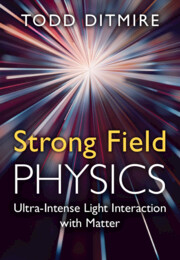Book contents
- Strong Field Physics
- Strong Field Physics
- Copyright page
- Contents
- Preface
- 1 Introduction to Strong Field Physics
- 2 Strong Field Generation by High-Intensity Lasers
- 3 Strong Field Interactions with Free Electrons
- 4 Strong Field Interactions with Single Atoms
- 5 Strong Field Interactions with Molecules
- 6 Strong Field Nonlinear Optics
- 7 Strong Field Interactions with Clusters
- 8 Strong Field Interactions with Underdense Plasmas
- 9 Strong Field Interactions with Overdense Plasmas
- Appendix List of Symbols
- Bibliography
- Index
5 - Strong Field Interactions with Molecules
Published online by Cambridge University Press: 05 July 2025
- Strong Field Physics
- Strong Field Physics
- Copyright page
- Contents
- Preface
- 1 Introduction to Strong Field Physics
- 2 Strong Field Generation by High-Intensity Lasers
- 3 Strong Field Interactions with Free Electrons
- 4 Strong Field Interactions with Single Atoms
- 5 Strong Field Interactions with Molecules
- 6 Strong Field Nonlinear Optics
- 7 Strong Field Interactions with Clusters
- 8 Strong Field Interactions with Underdense Plasmas
- 9 Strong Field Interactions with Overdense Plasmas
- Appendix List of Symbols
- Bibliography
- Index
Summary
Utilizing theoretical models from the previous chapter on multiphoton, tunnelling and above-threshold ionization, this chapter presents models for the ionization and fragmentation of small molecules in strong laser fields. Ionization models from the strong field approximation and a molecular tunneling model are presented, augmented with considerations of the additional complications arising from multiatom systems such as vibrational excitation, multielectron effects and molecular alignment. Mechanisms for aligning a linear molecule in a moderate-intensity laser field are discussed, followed by a section scrutinizing the fate of molecular bonds in moderate fields. Aspects of molecular bond evolution such as bond softening and above-threshold dissociation are explored using the Floquet theory of quantum systems in strong fields. The final portion of the chapter describes the dynamics of Coulomb explosions of diatomic molecules subsequent to laser field ionization, and the critical ionization atomic separation distance at which field ionization is enhanced. A concluding section considers fragmentaion of polyatomic molecules.
Keywords
Information
- Type
- Chapter
- Information
- Strong Field PhysicsUltra-Intense Light Interaction with Matter, pp. 262 - 315Publisher: Cambridge University PressPrint publication year: 2025
